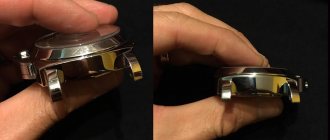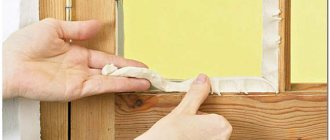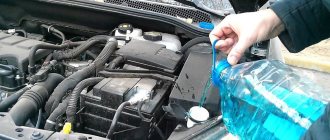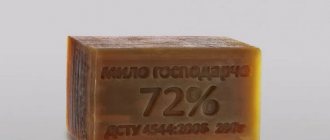How to remove film from glass
The process of removing film from a window itself can be long and labor-intensive, so you need to stock up in advance not only with all the necessary tools, but also with time and patience.
Soaking method
To remove window tint film, you will need a bowl of water, a flannel cloth, and dish soap. The process itself looks like this:
- Dishwashing detergent must be added to the water. The liquid should become quite soapy.
- Now you need to moisten a flannel cloth in this water (you can take a simple diaper) and stick it to the glass for 2 hours. If during this time the fabric dries out, it needs to be moistened with soapy water, for which you can use a spray bottle.
- After 2 hours (the fabric can be kept longer), the solar film needs to be lifted with something, for example, a spatula or scissors, and its edge pulled down 2 cm. If it doesn’t come off well, then spray soapy water into the gap between it and the glass and try again after 10 minutes.
- Remove the self-adhesive film from the glass completely, periodically wetting it during operation, which will make the process easier. In this case, you absolutely cannot rush, since there is a risk of tearing the film, and then you will have to start all over again.
- Finally, wash the window with a solution of ammonia.
Steaming method
You can remove the sun protection film from the window using a steam generator. To do this, a jet of hot steam is first directed at the top of the glass. Processing should be carried out for at least 7-10 minutes, until the film begins to easily peel away from the glass. After this, you can move to another area. So gradually you need to clear the entire window of the tint film.
After this, you need to process the already freed glass. Wash the window with soapy warm water (you must first dissolve dishwashing detergent in it) or a solution of ammonia (50 ml of ammonia per 10 liters of water).
Heating method
Tint film is most often made from polymer materials. This means that it cannot withstand high temperatures, so it can be removed by heating.
You will need a tool capable of heating the stained glass film to +50°C, which will allow it to become more plastic, which means it will easily separate from the glued surface. A hair dryer works best for this task. You need to keep it at a distance of 10 to 15 cm from the window. Heating of the surface should be as uniform as possible - if this rule is ignored, the glass may crack due to overheating.
After treating the entire surface, a stream of hot air should be directed to the upper corner and held in this position for several seconds. Then remove the hairdryer, pry off the film with a sharp, but non-metallic object (for example, a plastic spatula or toothpick), and then gradually remove the coating, warming it up if necessary.
This method of removing tint coating (as well as the method using a steam cleaner) is only suitable for the warm season. This precaution avoids possible temperature changes and damage to the glass.
How to remove solar control film or foil from a window
All modern materials that protect our homes from high external temperatures contain not only aluminum, but also other elements that complicate the process of removing them from the surface. To ensure that there are no noticeable stains or streaks on the glass, foil or film from the window is removed with special care. There are the most popular methods for cleaning windows from PVC film.
Steaming against old adhesive tape
Using a modern steamer, you can easily remove the film from the window. The entire cleaning process must be carried out in several stages.
- A small area on the window must be heated with hot steam produced by the steamer. In this case, it is important that its direction is pointwise and not over the entire area of the window.
- After 5 minutes, you should lift a small section of the film and then pull it towards you, thereby separating the film from the window.
- We do the same with the new area until the entire window is clear of solar control film.
This is the most basic and gentlest option for film removal. And even if there are traces left on the window after it, they are removed using a regular soap solution.
Removing film using a steamer is the most gentle way
How to wash mirror film using newspaper
The sun protection film can also be removed using ordinary soapy water and newspaper. This work is done in several stages.
- Regular newsprint is placed over the glass area.
- Next, the newspapers are sprayed with a soapy solution until they stick to the window.
- The paper is left for 60 minutes and constantly wetted.
- The film along with the newspaper is much easier to remove after such a procedure.
When removing film from the window frame, you must be careful not to damage the surface.
Other means and methods
Cleaning agents and detergents that can be used to remove adhesive tape from window frames are suitable for removing stains and film from the glass surface. In addition to the already mentioned Cosmofen and Schumanite, effective substances such as:
- Phenosol;
- Domax (the product is intended for gentle care of ceramics and glass, so it does not contain abrasive substances).
But even these very powerful tools do not always cope with the task. In this case, you need to use a hard scraper or choose another method of cleaning the film from the window.
How to remove film using detergents and cleaning products
Special chemicals will also help to remove sun protective film or foil from glass. But in this case, compliance with safety measures is required, for example, you need to work in rubber gloves, tight closed clothing, and a respirator. In addition, the room should be well ventilated, and children, animals and plants should be removed from the room.
The following remedies are effective:
- Soap solution. You can make it from any soap, which you need to grate (if it’s a piece) or immediately dissolve it in water (if it’s liquid).
- Cleaning products for glass-ceramic kitchen stoves, for example, Domax, Sanita, Master Clean or any other that you have at home.
- Preparations for cleaning tiles: Schumanit, Titan, Domestos, Cif and many others.
- Dishwashing detergents.
- Solvents, for example, turpentine, solvent, white spirit, Toluene, Orthoxylene. They need to be applied a few drops into the gap between the film and the glass (make sure that the product does not get on the rubber seal). The effect should be visible immediately - rainbow stains appear at the site of application of the product. If they are not there, then you can try another option.
- Window cleaning products.
If the coating does not come off well after treatment, you can help yourself with a scraper.
All products cannot be considered universal, since everything depends on the film material used, the method of applying it to the glass and the duration of its stay on it.
Removal using solvents
All polymer films, including reflective ones, are sensitive to nitro solvents. Therefore, to remove them, you should never use liquids containing acetone or similar chemicals. Otherwise, you risk dissolving the polymer base, turning it into a viscous mass, leaving glue on the glass.
As a solvent for glue, it is necessary to use either the solvent recommended by the manufacturer, or select it experimentally by conducting a series of tests.
For testing, use pieces of film left over after repairs, or peel off a corner of the film on the window glass using one of the methods described above.
Important to remember! Working with solvents requires the mandatory use of respiratory protection - a protective respirator with cartridges for working with chemicals, or a gas mask.
Remove all plants and pets from the room (especially cold-blooded ones - fish, amphibians, reptiles)! Work without children!
Windows must be open when working!
The most suitable solvents for film removal are those based on petroleum distillation products - gasoline, naphtha, solvents:
Or alcohol-based - isopropyl alcohol, formic alcohol, formaldehyde, etc.
After peeling off a corner of the film, use a pipette to apply a few drops of solvent between the film and the glass. If the solvent is effective, a rainbow-colored spot should form between the film and the glass, and the film should separate from the glass without any effort.
Apply the solvent between the film and the glass using a pipette. The exposure between the application of the solvent and the film separation time is 1-3 minutes.
The process can be controlled visually by the formation of a rainbow layer between the film and glass.
How to remove paper stickers from glass
It can be difficult to remove a paper label from the glass of a window, car, dishware or piece of furniture because it cannot be peeled off: the sticker material is impregnated with glue and adheres tightly to the surface. In this case, before removing the sticker itself from the glass, it is recommended to treat it.
Heating with a hairdryer will help remove the sticker neatly and without leaving marks.
To do this, you can use the following methods:
- Heating with a hairdryer. When exposed to high temperatures, the glue dries out and loses its properties. Therefore, before you start peeling off the sticker, experts recommend heating it with warm air for a couple of minutes using a hair dryer. Then you should carefully lift the edge of the label from the glass surface and pull it up. It should come off easily.
- Treatment with warm water. You can clean labels from glassware using warm water. New dishes can be placed in a container of hot water and left there for an hour or two. Then all that remains is to rinse the plates, glasses or cups under running water. This method helps remove paper without leaving a trace.
- Mayonnaise. This method is good because it helps to deal with stickers on products that are difficult to soak or heat with a hairdryer, for example, on car windows. The problem area should be smeared with a popular sauce, left for 20-30 minutes, and then peel off the sticker and wash off its traces with soapy water.
- Alcohol, acetone or other solvent. These products come in handy when you need to deal with an old sticker on a car or window. If you can’t wash it off with water, the website sympaty.net recommends moistening a gauze cloth in strong alcohol and applying it to the stain. After a minute or two, try to wipe it off. If it doesn’t work right away, repeat the manipulation several more times. Then rinse the cleaned area of glass with water.
Soaking
You can remove foil from window glass by soaking it. To do this, you need to take a flannel diaper or just a piece of fabric. Soak in water with any dishwashing detergent and apply to the surface of the window. Leave for two hours so that the fabric does not dry out, spray with a spray bottle.
Remove the diaper, carefully pry a corner of the cover with a knife or spatula, and pull it towards you. If it separates poorly, spray a soap solution between the glass and the film, wait 10-15 minutes, and continue further. After release, wash the glass with water and ammonia.
How to remove glue from a glass surface?
After removing a sticker made of synthetic materials or paper, glue remains on the glass. This problem especially concerns bottles.
This sticky layer is sometimes much more difficult to remove than the label itself.
What means will help solve the problem? Housewives, through many years of experience, have developed a lot of folk remedies that can cope with it:
- Vinegar. A cloth is moistened in it and the dirt is rubbed with pressure. Wash off with warm water. Usually this method works well, and vinegar also makes the glass shine.
- Alcohol. Instead, strong vodka often helps solve the question of how to remove sticker marks from glass. It is used according to the same rules as vinegar.
- Acetone or white spirit. These compositions are used when neither vinegar nor vodka cope with the task. If you managed to remove the sticker from the car window, but matte strips of glue remain in its place, go to the garage and start fighting it using a special glass cleaning liquid or white spirit.
- Melamine sponge. An innovative product will help you quickly wipe away traces of glue from a plastic window - a sponge that can wipe off various types of dirt from almost any surface. When wet, it acquires the properties of an eraser. This soft abrasive has the ability to clean surfaces without adding any detergents. The main thing when using a sponge is to thoroughly rinse off any remaining residue from the glass surface.
- Stationery eraser. It is often used by experienced housewives to remove various contaminants. It can also remove sticker glue from glass.
- A special microfiber cloth for cleaning glass. Such products do an excellent job of removing traces of glue, for example, from adhesive tape. You just need to rub the stained area a little.
Melamine sponge for cleaning and cleaning
Methods for cleaning the surface of tape and stickers from furniture, frames, and plumbing fixtures
It is important to keep each piece of furniture clean and tidy, then it will last longer and will please the eyes of others. But not everything is as shiny as you would like: here is a stain from a child’s sticker, but ink has been spilled, and what to do when dirt appears on the plastic windows and ceiling. There is dirt and dust all around, but you want cleanliness and comfort - there is a solution.
We clean the stain from the “cute” sticker and other sticky “creations”:
- How to remove glue from a sticker. You can try scraping it off manually with your fingers, without using improvised materials.
- You can remove stains from glass, wood, metal and plastic with a sharp blade, completely removing any remaining glue.
- If the results remain disastrous, then a detergent will come to the rescue. In this way you can remove traces of glue from the sticker. Those who do not want to deal with chemistry can try using olive oil, white vinegar or peanut tincture. Thanks to the environmental friendliness and harmlessness of such products, you don’t have to worry about damaging the elegant surface.
- How to remove a sticker from plastic? Stubborn stains cannot be overcome without stronger substances; isopropyl alcohol, nail polish remover, grease remover and other synthetic solvents will do the trick. Before using them, it is advisable to carefully read the instructions and try their effect on small areas so as not to damage the entire surface.
- How to remove stickers from the refrigerator. You can try soaking it in warm soapy water, and then clean it with a damp cloth and wipe with a dry towel.
- Barcodes can be easily removed with the hot air of a hair dryer, this applies to dishes, porcelain, cars, and decorative items.
- How to remove a sticker from plastic, you can remember the school eraser, which perfectly removes old traces of Velcro on smooth surfaces.
- A modern remedy - a melamine sponge - removes such stains from vinyl wallpaper without damaging its integrity and appearance.
How to remove traces of tape from any surface
Tape cleaner
The “wedge by wedge” method, another piece of tape is glued to the surface and removed with a sharp movement. If it doesn’t help, then we’ll figure out further how to clean the window from adhesive tape , the stain of which has long dried up and cannot be removed. You can apply something greasy to the marks, for example, butter or vegetable oil, and remove the remaining material with a dry kitchen sponge.
How to remove double-sided tape
Nail polish remover can easily cope with this task, but it is better not to use this method on wooden or varnish products. A dry eraser or Label Remover spray for removing sticky stains will work here.
How to remove tape from furniture
A safer way is to heat the surface with a hairdryer and wipe with a swab dipped in vegetable oil. Essential oils cannot remove tape stains, but you can remove gluten, and then wipe off the stains with microfiber.
How to remove tape from plastic
This can be done in several ways:
- A swab is moistened in white alcohol or purified gasoline and the damaged area is rubbed.
- Kitchen gel and dishwashing detergent.
- Using Mr. Muscle Window Cleaner. The stain is soaked for a few minutes and then wiped off with a cloth.
Removing old mounting film from a plastic frame
The best way to remove old film from a frame is a steam cleaner; you can take a regular Karcher and use a hot jet to soften the material and remove traces of contamination with a clean, dry waffle towel. The sticky mark can be easily wiped off with nail polish remover; here’s how to remove film from glass easily and safely.
How to remove stains from the ceiling
Over time, the snow-white ceiling may no longer please the eye of the owner of the room. Various stains appear, which sometimes depress and haunt clean housewives. Stop! To clean the surface you will need the following materials:
- roller;
- White paint;
- putty.
First, dust is removed from the ceiling, a primer is applied, and after complete drying, the marks are painted over with oil paint. Often, after the first painting, yellow spots still appear, which means you need to treat the stains with bleach and paint again. After such simple procedures, the ceiling becomes fresh and clean, ready to please your household every minute.
How to get rid of superglue traces?
Cooled, dried glue causes a lot of inconvenience, especially when it sticks to your hands, new furniture, a soft corner or table surface. In such cases, a sound method of cleaning the “sticky compound” does not always come to mind, but scraping and rubbing your fingers on sandpaper is not recommended.
It is prudent to work with superglue while wearing gloves, but if such an embarrassment has already happened, then you need to apply a rich cream to your hands, hold for 10-15 minutes and wash off with warm water and soap.
How to deal with decorative stickers?
Such “decorations” are often purchased by car enthusiasts. They stick New Year or “victory” badges on the windshield or rear window for beauty, but when selling the car, they don’t remove it. Decorative stickers sometimes interfere with the new owner’s ability to even drive calmly, because they are distracting. Fortunately, removing them is quite possible.
The main thing is not to rush to peel it off with a spatula or brush right away: the glass will be scratched, and the marks will not go away completely.
In such a situation, the following methods will be useful:
- Alcohol based products. They should treat the problem area, and then tear off the vinyl sticker. Then proceed to remove the sticky residue using one of the methods described above.
- Industrial dryer. The vinyl needs to be heated thoroughly to wrinkle it. Then you can carefully tear off the label. If any glue remains, remove any remaining glue from the glass using an acetone-based solvent.
- Wallpaper remover. The best existing formulations are considered Kelid Dissukol, EC concentrate, Pufas Tapetenabloser, Pufas Tap-Ex. Any of this list is applied to the problem area using a sponge or spray bottle. Let it work for a minute, then carefully pry up the edges of the sticker and remove it. Then they once again treat the area where it was located and wash off the remaining cleaner with water.
- Degreaser WD-40. The problem of how to remove a sticker from glass can be solved by using this chemical. Plastic cannot be treated with this composition: the surface of the product will be damaged.
- Ice. Stickers are afraid of the cold. It is enough to apply ice cubes to them and hold them for a couple of minutes, the labels will begin to give in, you can simply peel them off the glass and treat the traces after them with a solvent.
- Aviation gasoline. The composition will help if the glue is made of rubber. To apply fuel to the sticker, wear a glove and use a sponge. The gasoline is allowed to run for 10 minutes, then processed again. When the edges of the label begin to lag behind, you need to grab one of them and pull. Wash off remaining gasoline with soapy water.
Wallpaper removers can remove stickers on glass
Removing stickers is an easy task. The main thing is not to act rashly, but to turn to modern household chemicals. A little patience, a little accuracy - and the faded old sticker will disappear! To prevent this issue from arising in the future, try not to apply new stickers, or at least remove them immediately after they are no longer relevant.
Source: www.sympaty.net
How to remove solar control film from a window?
Plastic windows are often equipped with various films that are needed to protect from the sun, give the glass greater strength, and decoration. When purchasing an apartment, the windows can be covered with such films, but the new owner does not always need them. In addition, if the time has come to update the windows, since films tend to become unusable, the question arises of how to remove the solar control film from the window.
How to remove film from plastic windows
The profile of a plastic window is covered with a special film, which protects it from dirt, scratches and other mechanical damage during delivery and installation. It is very easy to remove it from the product, but it must be done in time. It is advisable to start this immediately after the window is installed. Otherwise, it will be necessary to resort to more radical methods of cleaning the film from the profile.
Coating removal methods
You can remove sun protection film from glass in different ways, choosing the most convenient and affordable one. This is done both mechanically and with the help of various detergents; they also use a combined approach in order to clean efficiently.
The film can be quite useful: it has a small thickness, but at the same time it makes the window much stronger; it can no longer be broken with a simple stone. There are different types of films that help protect the glass unit even from strong impacts, such as a shot; They are classified as protective. It will not be possible to remove perforated film from glass or any other type of protective or tinting from the outside: an attacker will not do this, since the process requires a lot of time, effort, and attracts the attention of others. Most films are glued on the inside, with the exception of the protective one.
Knowing how to remove film from window glass may be necessary if you want to replace it when updating the interior or replacing a double-glazed window. Sometimes a product loses its visual appeal and requires updating, or the owners of the room want to change its lighting, make the room lighter or darker. The process of removing film is simple and does not require hiring a specialist, but it is worth considering that you will have to spend a sufficient amount of time and effort on this. You need to work carefully: in the process it is easy to damage the glass and scratch it, especially if you remove the film using hard materials like a spatula or a rough brush.
Useful tips
To ensure that you are pleased with the results of your window film removal work, adhere to the following rules:
- Remove the protective film immediately after the window is installed. And if the installation work has not yet been completed, then it is better to stick masking tape on the surface of the window. This way you can avoid not only contamination, but also damage to the surface of the PVC profile during the repair process. Then, after completing all the work, you will not need to make great efforts to remove the stuck tape;
- After removing the protective sticker, treat all moving parts of the fittings with lubricant;
- do not use abrasive substances;
- when using chemicals, take into account their level of impact on the PVC surface, otherwise you can damage one of the layers of the window at the micro level;
- work with sharp objects carefully, and if possible, remove the film with your fingers so as not to leave scratches on the profile;
- Do not use strong solvents that can damage the profile.
Before you begin removing the film from the PVC window, you must complete all installation work. In this case, the excellent appearance of the window opening will please you for a long time. The exception is those types of work after which you physically cannot remove the film.
Source: legkovmeste.ru
What should you do when you need to remove film from a window?
When choosing a method, means, or option for cleaning glass, room owners take into account several parameters:
- You must not harm the glass.
- Spend as little time as possible on this.
- The option should be inexpensive.
- There should be no traces of glue, film residues, or various contaminants left on the glass.
The easiest way to remove the sun-protective film from glass is to use a spatula and your fingers. Some types can be carefully pryed off by grabbing the edge and tearing it off, but this does not always happen due to the fact that the film is glued unevenly, is damaged in places and peels off.
It is quite difficult to remove film adhesive from glass. It is difficult to remove with detergents and is not susceptible to mechanical action. In order to remove it, you can use white spirit or another alcohol-containing substance that can gently clean the surface. You should not use rags with coarse pile, as this may leave marks on the glass that are visible in the sun.
Understanding how to remove old film from plastic windows may be necessary if it is damaged, you want to change the appearance of the window, or you want to renew an old coating that has deteriorated.
Why is it difficult to remove protective film from a window?
The instructions for plastic windows usually indicate that the film must be removed within 2 weeks after installation. Removing the film will not cause much difficulty in the coming months. However, if it remains on the profile for more than 4 months, a lot of effort will have to be made to remove the film.
It is advisable to remove the film within 2 weeks after installing the window.
For what reasons could this problem occur? The film contains several layers that are attached to the profile using special glue. Strong bonding with plastic occurs under the influence of solar radiation, as well as heat. In other words, the process of decomposition of the inner very thin layer of the film occurs. Therefore, the inner layer is much more difficult to remove than the surface layer.
Reasons that contribute to increased adhesion of film and PVC frame:
- action of heat. In summer, the film dries to the frame much faster than in winter;
- The quality of the special glue applied to the film affects the difficulty of its removal. The cheaper the windows, the lower the quality of the glue;
- exposure to UV rays. The adhesive layer of film on windows located on the south side of the building may dry out faster. Therefore, it can be more difficult to remove film on such windows than on windows located on the north side.
What methods for dismantling are there?
Removal methods can be divided into two – mechanical and chemical. The first allows you to remove film from plastic windows without spending much money, but with the risk of scratching the glass. The second will take longer and cost more, but with the right products you can thoroughly clean the surface without causing harm to it. For greater effectiveness, it is best to combine the methods: first, you will need to tear off all swollen, cracked or otherwise deteriorated film.
You can remove the film from plastic windows by hand, then get rid of the glue using substances such as COSMOFEN 10, FENOSOL. These detergents have a cheaper alternative that you can buy at a hardware store: it's called P-12.
You should try to heat the surface evenly: the better you do this, the easier it will be to remove the self-adhesive film from the glass and the remnants of its glue. The latter will not be easy to remove; you will need to use a solvent, a scraper and detergents. You need to act carefully, otherwise you may scratch the glass. A steam generator can help in this matter. With its help, you can remove stained glass film from glass , get rid of tinting or protective film, and glue residues. If you don’t have a steam generator or a powerful hair dryer at hand, you shouldn’t try to heat it up with an iron. This way, the film will not be removed, but it will partially stick to the surface of the iron, which can significantly damage it, and after cooling it will not be easy to tear it off from the iron.
You can remove the self-adhesive film from the glass, if it is warmed up well, using a hard eraser for artists. Eraser residue can be easily removed from the window. To do this you need a dry sponge or rag. If there is any glue left, you can reapply the eraser or use a solvent. Most hardware stores will have something to remove film from glass.
Source: oknanagoda.com
How to remove Oracal self-adhesive film
Nowadays, printing on film has become commonplace, but sometimes you have to perform the opposite action - remove the self-adhesive film (SAF). The main thing is not to cause harm to the material on which it is glued.
Basic methods of film removal
Common to most methods is heating: 1. Using hot water (wet it generously); 2. Hairdryer (household or industrial); 3. A heater directed at the gluing site.
After softening the SCP, it is carefully removed by hand or with a spatula/scraper. It is necessary to warm up individual areas, holding the hairdryer about ten cm from them, and scrape as they warm up.
It will be more difficult to eliminate cheap, low-quality films, especially if the glue extends beyond their edges. It is recommended to preheat them to 50°C and then peel them off; if it doesn’t work out, scrape it off.
Elimination of expensive self-adhesives - automotive or temporary - is usually done manually; heating is not required. You can also use an aerosol sticker remover (classified as automotive products): spray it under the film and slowly tear it off.
Removing Oracal film
Popular printing on film is done in any format, but the biggest problem is the dismantling of large street banners. In the warm season, you can remove Oracal from the wall of a house or from a billboard without major problems, the exception being if its structure has changed as a result of long-term use and exposure to sunlight. In this case, traces of glue with dust adhering to them will remain on the wall/billboard. However, removal in the cold season, especially during frosts, is very difficult, since oracal, as a result of freezing, loses its elastic properties and breaks. In this case, it (or its narrow strips cut vertically) is heated with an industrial hair dryer and removed.
How to get rid of glue residue
Glue drips are usually removed using: 1. Solvent; 2. A special liquid that removes glue; 3. Eraser (a labor-intensive but reliable method that does not damage the surface).
The surface may suffer from exposure to a low-quality solvent. When a “delicate” approach is needed, use nail polish remover; white spirit is least harmful to furniture. For subsequent renewal of the coating, the remaining SCP and glue must be sanded.
Due to the rapid evaporation of nitro solvent, traces of glue should be wiped with a rag as soon as possible.
After removing Oracal, the wall/billboard plane, if necessary, is also treated with a solvent.
Remember: safety precautions include protective gloves, glasses, and, if possible, a respirator; the room must be thoroughly ventilated.
We wish you success and hope that these rules and recommendations are useful!
The opinions of the authors of articles may not coincide with the position of the editors.
Found a spelling mistake? Select it with the mouse and press Ctrl+Enter
Source: www.kchetverg.ru
How to remove film from glass or other surface
Self-adhesive vinyl films and perforated film are used to create an attractive interior, branding vehicles, covering shop windows, tinting windows, designing information signs and signs. But over time, the material wears out and must be replaced. At such a moment, the main question arises: how to remove self-adhesive tape from glass or any other material without damaging it.
To properly remove self-adhesive from glass, it is worth considering a number of factors:
- duration of operation - the longer this period, the stronger the degree of adhesion of the photographic film to the surface;
- type of gluing and material itself;
- influence of external factors.
How to remove Oracal from glass? You can remove the self-adhesive from the glass using a hair dryer. The oracal needs to be warmed up well with a warm air stream, while the distance should be controlled so as not to deform the main surface. Next, the self-adhesive is pryed off with a utility knife and carefully pulled off by the peeled part. The film should be torn off at an angle of 90°. This will allow you to separate parts of the adhesive layer without unnecessary difficulties.
How to remove film from a car without damaging the vehicle body
Very often, an image is applied to the car body in the form of a film coating. This can be done for advertising purposes or optionally to decorate the car with decorated elements. But wrap materials are short-lived, and car owners are beginning to wonder how to remove the film from the car. There may be several reasons why branding or inscriptions are removed:
- the sticker was damaged during the operation of the car;
- advertising has become irrelevant;
- there was a desire to change the boring slogan or picture to a new one.
The complexity of the work performed depends on the manufacturer of self-adhesives, their quality, and operating time. Stickers and glue residues are removed with an industrial hair dryer. To avoid damaging the paint, you should trust the removal of film from the car to specialists. Since often the entire car body is covered with advertising photographic films, through which it is impossible to view the details of the car.
How to glue self-adhesive film: nuances that need to be taken into account
If you decide to decorate the surface, then strictly follow the instructions, which describe in detail the process of gluing advertising photographic film. This guarantees a high-quality final result and ensures easy removal of the film.
When working with large structures, only professional workers can remove the self-adhesive from the glass without unnecessary difficulties. It is worth ordering gluing from a company that has extensive experience in this field. This service is provided by the advertising production company AMS Print. Our craftsmen skillfully work with various materials, fulfill orders with high quality and in optimal time frames. We carry out pasting of Oracal for the purpose of registration:
- shop windows;
- interior of private houses, office premises;
- public transport and corporate cars;
- trading floors.
Source: ams.net.ua
How to remove film from glass
The process of removing film from a window itself can be long and labor-intensive, so you need to stock up in advance not only with all the necessary tools, but also with time and patience.
Soaking method
To remove window tint film, you will need a bowl of water, a flannel cloth, and dish soap. The process itself looks like this:
- Dishwashing detergent must be added to the water. The liquid should become quite soapy.
- Now you need to moisten a flannel cloth in this water (you can take a simple diaper) and stick it to the glass for 2 hours. If during this time the fabric dries out, it needs to be moistened with soapy water, for which you can use a spray bottle.
- After 2 hours (the fabric can be kept longer), the solar film needs to be lifted with something, for example, a spatula or scissors, and its edge pulled down 2 cm. If it doesn’t come off well, then spray soapy water into the gap between it and the glass and try again after 10 minutes.
- Remove the self-adhesive film from the glass completely, periodically wetting it during operation, which will make the process easier. In this case, you absolutely cannot rush, since there is a risk of tearing the film, and then you will have to start all over again.
- Finally, wash the window with a solution of ammonia.
Steaming method
You can remove the sun protection film from the window using a steam generator. To do this, a jet of hot steam is first directed at the top of the glass. Processing should be carried out for at least 7-10 minutes, until the film begins to easily peel away from the glass. After this, you can move to another area. So gradually you need to clear the entire window of the tint film.
After this, you need to process the already freed glass. Wash the window with soapy warm water (you must first dissolve dishwashing detergent in it) or a solution of ammonia (50 ml of ammonia per 10 liters of water).
Heating method
Tint film is most often made from polymer materials. This means that it cannot withstand high temperatures, so it can be removed by heating.
You will need a tool capable of heating the stained glass film to +50°C, which will allow it to become more plastic, which means it will easily separate from the glued surface. A hair dryer works best for this task. You need to keep it at a distance of 10 to 15 cm from the window. Heating of the surface should be as uniform as possible - if this rule is ignored, the glass may crack due to overheating.
After treating the entire surface, a stream of hot air should be directed to the upper corner and held in this position for several seconds. Then remove the hairdryer, pry off the film with a sharp, but non-metallic object (for example, a plastic spatula or toothpick), and then gradually remove the coating, warming it up if necessary.
This method of removing tint coating (as well as the method using a steam cleaner) is only suitable for the warm season. This precaution avoids possible temperature changes and damage to the glass.
Soaking reflective films
If the film is glued to the glass of a plastic window using an aqueous solution with the addition of surfactants (surfactants), then it is logical to assume that the glue used by the manufacturer is water-soluble.
The simplest method is the old soaking method.
For this you will need:
- cotton or semi-synthetic fabric, which in size completely corresponds to the size of the window glass;
- spray;
- foam paint roller;
- basin for solution with surfactants;
- construction scraper with replaceable blades;
- plastic or rubber spatula.
Step 1
Over the summer, the film has time to dry out, and the structure of the polymer becomes fragile. It needs to be thoroughly soaked in water to remove it. Cut a piece of canvas 10-20 mm larger in length/width than the dimensions of the plastic window glass, so that it bends slightly onto the PVC profile of the window frames. Soak it in a solution with a surfactant. To do this, you can use any detergent, but the best one is dishwashing detergent - “Fairy”, “Sorti”, “Dosya”, “Kaplya”, etc. or window cleaner.
Step 2
Moisten the surface of the film with a solution containing a surfactant from a spray bottle and stick a wet cloth on it. Spray the fabric periodically to keep it moist. Take your time! The longer the film soaks on the plastic window, the easier it will be to remove it from the glass. Minimum exposure – 1 hour.
Step 3
Using a fingernail or a sharp object (toothpick, plastic spatula), pick up the film at the upper corner of the window and try to separate it from the glass by 10-20 mm. After this, moisten the separated area with a spray bottle so that the solution gets between the adhesive surface of the film and the glass. Leave for 5-10 minutes.
How to remove film using detergents and cleaning products
Special chemicals will also help to remove sun protective film or foil from glass. But in this case, compliance with safety measures is required, for example, you need to work in rubber gloves, tight closed clothing, and a respirator. In addition, the room should be well ventilated, and children, animals and plants should be removed from the room.
The following remedies are effective:
- Soap solution. You can make it from any soap, which you need to grate (if it’s a piece) or immediately dissolve it in water (if it’s liquid).
- Cleaning products for glass-ceramic kitchen stoves, for example, Domax, Sanita, Master Clean or any other that you have at home.
- Preparations for cleaning tiles: Schumanit, Titan, Domestos, Cif and many others.
- Dishwashing detergents.
- Solvents, for example, turpentine, solvent, white spirit, Toluene, Orthoxylene. They need to be applied a few drops into the gap between the film and the glass (make sure that the product does not get on the rubber seal). The effect should be visible immediately - rainbow stains appear at the site of application of the product. If they are not there, then you can try another option.
- Window cleaning products.
If the coating does not come off well after treatment, you can help yourself with a scraper.
All products cannot be considered universal, since everything depends on the film material used, the method of applying it to the glass and the duration of its stay on it.
Precautions when removing film residues from glass and plastic
When working to remove solar control or regular film from a window, precautions should be taken. It is necessary to use protective agents against chemicals that have a negative effect not only on human skin, but also on his respiratory tract. Sharp objects must be used carefully to avoid injury. Try to follow the following rules:
- work with chemicals wearing impervious and very durable rubber gloves;
- Do not press too hard on the glass, as it may break;
- use extreme caution when using a scraper, scissors, knife or other sharp objects to avoid scratching the window or injuring yourself;
- do not allow chemicals to get into your eyes, skin, or respiratory tract;
- Keep tools and materials used to remove film marks out of the reach of children.











